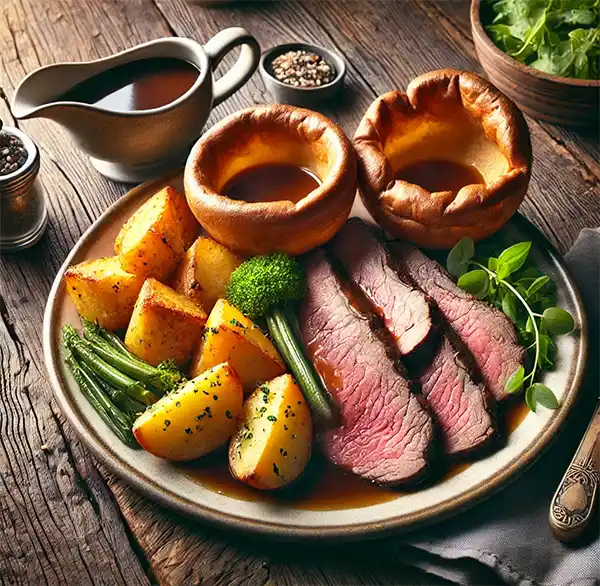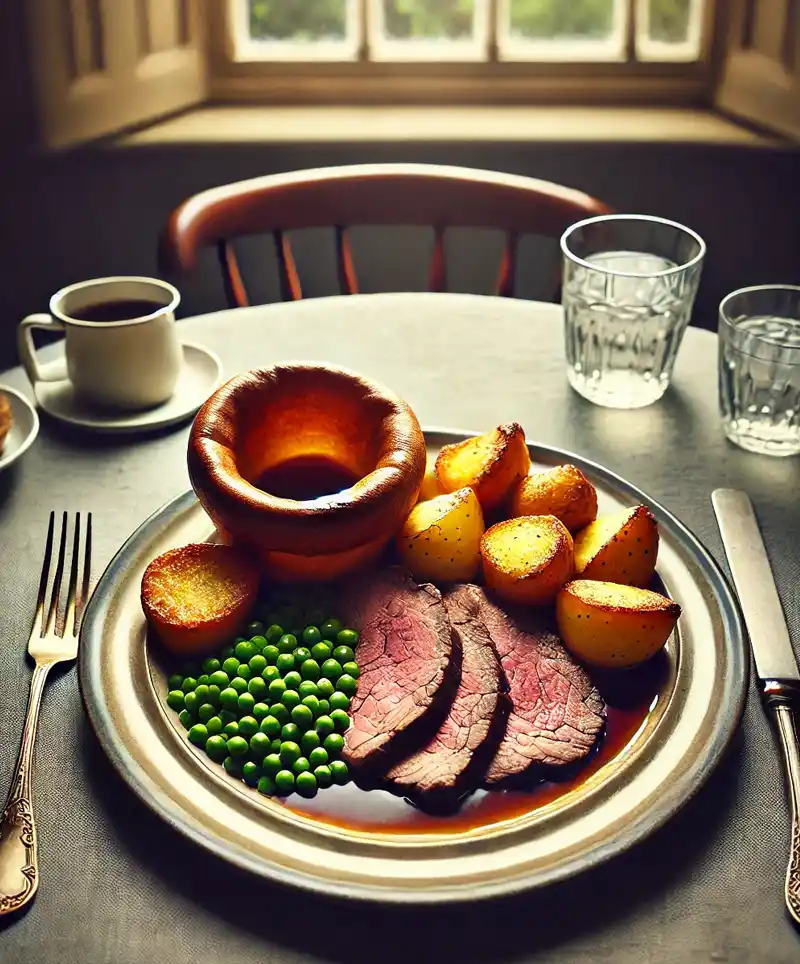The Fluffy Crown Jewel of British Cuisine
Yorkshire pudding—just hearing the name conjures images of golden, puffed-up clouds of deliciousness. For the uninitiated, it might sound like some sort of sweet, creamy dessert, but don't be fooled. Yorkshire pudding is the savory star of Sunday roasts across the UK, and it's so beloved that it gets its own day of celebration: National Yorkshire Pudding Day, marked on the first Sunday of February.
 Let’s dig into the history, quirks, and undeniable charm of this iconic British side dish and find out why it’s earned a day of culinary recognition.
Let’s dig into the history, quirks, and undeniable charm of this iconic British side dish and find out why it’s earned a day of culinary recognition.
What Exactly is Yorkshire Pudding?
First things first: Yorkshire pudding is not a pudding in the way most people around the world understand it. In the UK, the word "pudding" can refer to any dish, sweet or savory, that's cooked with a batter or dough. Yorkshire pudding is made from a simple batter of eggs, flour, and milk (or water) and is typically baked in a hot oven until it rises dramatically, forming a crisp, golden exterior and a soft, hollow inside.
The magic of Yorkshire pudding lies in its versatility. Traditionally, it’s served alongside roast beef and smothered in gravy, but this humble dish can be adapted to all sorts of meals. You can fill it with sausages for a classic Toad in the Hole, or you can get creative and stuff it with leftovers, meats, or even use it to mop up sauces. No matter how you eat it, Yorkshire pudding is pure comfort food in its most dramatic, puffed-up form.
A Brief History of Yorkshire Pudding
Yorkshire pudding has been around for centuries, though its exact origins are a bit murky. What we do know is that by the 1700s, a dish called "dripping pudding" was being made in England. Cooks would place a pan of batter underneath roasting meat, allowing the drippings to flavor the pudding as it cooked.
The first recorded recipe for a similar dish appeared in 1737 in a cookbook titled The Whole Duty of a Woman, which, judging by the title, clearly had some opinions about gender roles in the kitchen. The dish evolved into what we now recognize as Yorkshire pudding, and it was mentioned in 1747 by Hannah Glasse in The Art of Cookery Made Plain and Easy—one of the most influential cookbooks of the 18th century.
Over time, Yorkshire pudding became synonymous with the roast beef dinner, a staple of British Sunday lunches. It wasn’t just a way to make the most of meat drippings, but also a hearty way to stretch a meal. When times were tough, Yorkshire puddings were often served before the main course to fill up diners so they wouldn’t need as much meat—a strategy both thrifty and delicious.
The Science of Puff
Yorkshire pudding’s towering rise is all about science. The batter, made with eggs, flour, and liquid, is poured into a blisteringly hot pan that has been generously greased with fat—traditionally beef drippings, though oil or lard works too. As the batter hits the hot pan, it begins to cook from the outside in, trapping steam inside. The steam puffs up the batter, and as it continues to bake, the outside crisps up, while the inside remains soft and hollow.
The key to a perfectly risen Yorkshire pudding is all about heat—both the oven and the pan must be incredibly hot before you pour in the batter. That’s what gives it that signature puff and crunch. If the temperature drops too quickly, or if you peek inside the oven too soon, your puds will collapse faster than a soufflé on a cold day.
 The Yorkshire Pudding Variations
The Yorkshire Pudding Variations
Yorkshire pudding may be classic, but it’s also a dish that invites a bit of playful experimentation. While the traditional roast beef accompaniment is the gold standard, here are a few creative ways Yorkshire pudding has been served up:
-
Toad in the Hole: This is the dish that takes Yorkshire pudding from sidekick to main attraction. Sausages are nestled in the batter before baking, and the result is a hearty, savory delight that needs nothing more than a drizzle of gravy.
-
Mini Puddings: These individual-sized Yorkshire puddings make excellent party appetizers. Fill them with savory fillings like pulled pork, mashed potatoes, or a dollop of horseradish cream for a bite-sized version of the traditional Sunday roast.
-
Yorkshire Pudding Wraps: Yes, you read that right. Some creative souls have taken to using large, flat Yorkshire puddings as wraps for beef and gravy, creating a sort of British burrito that’s both delicious and a little bit messy.
-
Dessert Yorkshire Pudding: Though not common, some daring chefs have ventured into dessert territory by serving Yorkshire pudding with sweet toppings like ice cream, fruit, or syrup. While this might raise some eyebrows, it’s proof that this dish is versatile enough to satisfy sweet tooths as well.
Yorkshire Pudding as a Drama Queen
There’s no denying that Yorkshire pudding is the diva of the roast dinner table. It demands a hot stage, thrives on attention (do NOT open the oven door while it’s rising!), and when it’s done, it enters the room with all the puffed-up pride of a rock star. But just like any good diva, when Yorkshire pudding flops, it does so dramatically—collapsing into a sad, soggy mess that no amount of gravy can redeem. But when it gets it right? Oh, it’s the belle of the dinner ball.
And let’s be honest—if you’ve ever tried to make Yorkshire pudding, you know that it’s the kind of dish that will make you feel like a kitchen wizard when it puffs up perfectly. But on the off chance it doesn’t? Well, there’s always more gravy to help smooth over the situation.
Celebrating National Yorkshire Pudding Day
National Yorkshire Pudding Day is a chance to celebrate this British classic in all its golden, fluffy glory. Here are a few ideas for how to mark the occasion:
-
Make Your Own Puddings: Roll up your sleeves and try your hand at making Yorkshire puddings from scratch. Just remember the cardinal rule: get that pan HOT before pouring in the batter. Whether they rise to epic heights or end up a little deflated, they’ll still taste delicious.
-
Host a Yorkshire Pudding Feast: Invite friends and family over for a proper British Sunday roast with all the trimmings—roast beef, gravy, vegetables, and, of course, Yorkshire puddings. Bonus points if you serve a dessert pudding afterward, just to keep everyone on their toes.
-
Experiment with Fillings: Try something new by making mini Yorkshire puddings and filling them with different savory ingredients. Pulled pork? Mashed potatoes? Cheese and onions? The sky’s the limit.
-
Yorkshire Pudding Challenge: If you’re feeling brave, you could even enter the world of competitive Yorkshire pudding making. There are competitions and festivals across the UK where chefs and home cooks alike compete for the title of Yorkshire Pudding King or Queen. May the best puff win!
On National Yorkshire Pudding Day, we celebrate a dish that’s been bringing joy to tables for centuries. From its humble beginnings as a way to stretch a meal, Yorkshire pudding has risen—quite literally—to become an iconic part of British culinary tradition. It’s a food that requires patience, precision, and a bit of drama, but the result is always worth it.
So, whether you’re a Yorkshire pudding purist or someone who likes to push the boundaries with creative fillings, take a moment to appreciate the simple beauty of this golden puff of dough. After all, in a world of fast food and fancy trends, there’s something truly comforting about a dish that’s stood the test of time—and still demands a spot on your Sunday roast plate.
Please Share our Content






 Let’s dig into the history, quirks, and undeniable charm of this iconic British side dish and find out why it’s earned a day of culinary recognition.
Let’s dig into the history, quirks, and undeniable charm of this iconic British side dish and find out why it’s earned a day of culinary recognition. The Yorkshire Pudding Variations
The Yorkshire Pudding Variations








 "Sláinte!" is a traditional Irish expression used as a toast, equivalent to "Cheers!" in English.
"Sláinte!" is a traditional Irish expression used as a toast, equivalent to "Cheers!" in English.